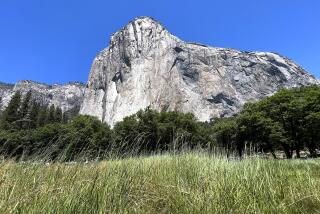National Parks Depend on Army of Volunteers
- Share via
PITTSBURGH — Volunteers will paint the buildings on the 19th century iron plantation of Hopewell Furnace in Elverson and help cut the grass at Ft. Necessity National Battlefield in Farmington, Pa. They will also greet visitors to Sagamore Hill National Historic Site in Oyster Bay, N.Y.
More than ever, National Park Service officials say, volunteers are being called on to help many of the 388 national parks deal with tight budgets.
This year’s Park Service budget is $2.56 billion, a 7% increase over last year’s $2.4-billion budget. Most of it is earmarked for operations, with the rest for building projects, land acquisition, historic preservation and maintenance.
But the Park Service had asked for $102 million more than Congress approved. And many parks are feeling the effects and doing more with less.
At Olympic National Park in Port Angeles, Wash., officials have cut staffing, forcing the visitor center in Forks to close two days a week. At Dinosaur National Monument in northwestern Colorado, jobs aren’t being filled. And a hiring freeze and maintenance cutbacks are likely for Acadia National Park in Maine.
At Gettysburg National Military Park in Pennsylvania, some open positions won’t be filled and some fees will increase.
“I think belt-tightening is a good way to characterize it,” said Ken Mabery, superintendent at the Ft. Necessity National Battlefield and Friendship Hill Historic Site in western Pennsylvania.
Mabery said the 900-acre park, which is mostly forested, has cut back on grass-cutting from every other week to about once a month, and is looking to volunteers to help get the job done. The park is also trying to organize a “friends of the park” group that would help raise money and organize volunteers.
“We very much enjoy being part of the community, and this is a way that folks can feel more like this park is part of who they are and who we are,” he said.
The Park Service has had a Volunteers-in-Parks program since 1970. In 2002, about 125,000 Park Service volunteers worked 4.5 million hours. “They’ve always been an integral part of how things run,” spokesman Gerry Gaumer said.
Volunteers give tours to schoolchildren, answer phones and greet visitors to Sagamore Hill National Historic Site in Oyster Bay, the home of Theodore Roosevelt. Last year, 60 volunteers contributed more than 5,000 hours to the historic site.
“They carry about the duties that we can’t do sometimes with the staff that we have,” said Jerome Stueart, a park guide.
Valley Forge National Historic Park has been finding more uses for volunteers, depending on them for everything from weeding to giving walking tours. It has also been using interns through the Student Conservation Assn. and gotten grants to help pay for interpreters.
With a permanent staff of about 80 people at the eastern Pennsylvania site, Valley Forge is lucky.
“We’ve been relying on volunteers for a very, very long time,” said Barbara Pollarine, the park’s deputy superintendent. “At these really small sites, it’s even more important” to use them, she said.
Joe Zagorski, a full-time park guide at the much smaller Hopewell Furnace National Historic Site, said the park is lucky to have a group of dedicated volunteers who paint, cut grass and give demonstrations.
“The way you try to address those issues is just to be as creative as possible, within park regulations,” Zagorski said.
Volunteers say they’re glad to help keep history alive.
Carl Kramer, a history major at Shippensburg University, has volunteered at Ft. Necessity for about a year and gives tours two days a week.
“I just like enlightening the visitors and telling them about history,” he said. “Just seeing on their faces how much you’ve helped them understand what happened there 250 years ago makes you feel good.”
More to Read
Sign up for The Wild
We’ll help you find the best places to hike, bike and run, as well as the perfect silent spots for meditation and yoga.
You may occasionally receive promotional content from the Los Angeles Times.






